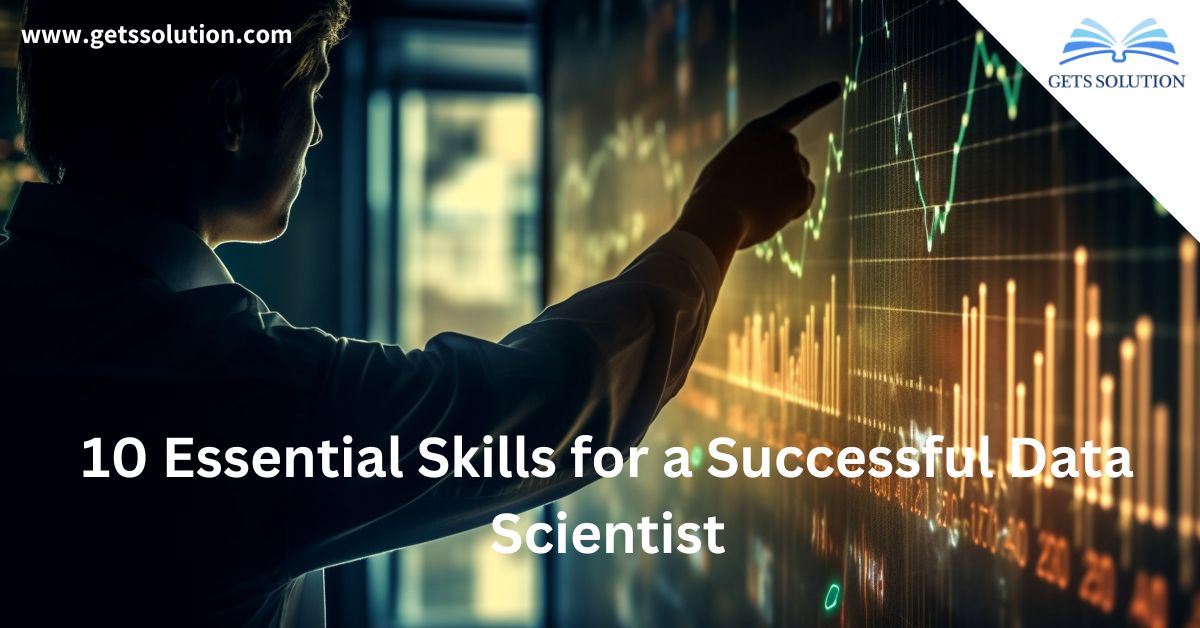The Thriving Landscape of Data Science
In today’s world, data isn’t just numbers on a spreadsheet; it’s the very lifeblood of businesses, driving decisions, shaping strategies, and revealing hidden insights that fuel innovation. At the heart of this data revolution stand the data scientists, the modern-day alchemists transforming raw information into gold. But what separates a proficient data wrangler from a truly successful data scientist? Buckle up, fellow data enthusiasts, because we’re about to unlock the secret ingredients that turn code into magic.
Why Data Science Matters in Today’s World
Imagine a world where businesses operate in the dark, oblivious to customer preferences, market trends, and potential pitfalls. That’s the world before data science. Now, imagine a world where every click, every purchase, every social media interaction becomes a brushstroke in a rich tapestry of human behavior, waiting to be deciphered. Data science illuminates this tapestry, revealing patterns, predicting outcomes, and empowering businesses to make informed decisions that lead to success.
The Allure and Challenge of Data Science
Data science is not just about crunching numbers; It’s about uncovering the stories hidden within the data. It’s the thrill of the chase, the satisfaction of connecting pieces of information into a coherent narrative, and the power to predict the future with remarkable accuracy. But this path is not paved with rose petals. It requires technical skills, intellectual agility, and an insatiable curiosity in exploring the unknown. So, are you ready to set out on this exciting journey?
Technical Mastery: The Power of Numbers and Code
Just as any skilled craftsman needs the right tools, a data scientist thrives on a powerful blend of statistical skills and programming prowess.
1. Statistical Prowess: Unraveling the Language of Data
Imagine that you are stepping into a library filled with countless books, each of which tells a mystery about the world. But unlike normal books, these books talk in the language of numbers, patterns, and probabilities. To understand them, you need a key to statistical skills.

Statistical skills aren’t just about crunching numbers; It’s about understanding the story they tell. It’s like learning a new language, where averages dance with deviations, where hypotheses are worth testing, and where correlations whisper hidden relationships. This mastery equips you with powerful tools to navigate the world of data and extract valuable insights from it.
Decoding the basics:
1. Descriptive Statistics:
This is the basic terminology, the alphabet of data language. You will learn to summarize information using measures such as mean, median, and mode, understanding how data clusters and where outliers are located. These statistics paint a comprehensive picture of your data, revealing central tendencies and highlighting potential anomalies.
2. Inferential Statistics:
Now, you graduate to advanced grammar, venturing beyond single data sets to conclude entire populations. This is where hypothesis testing becomes your detective game. You’ll formulate educated guesses, collect data as evidence, and analyze it using tools like p-values to determine if your hypothesis holds water. It’s about bridging the gap between samples and populations, making informed inferences about the bigger picture.
3. Regression Analysis:
Think of it as the sentence structure of the data. You’ll explore relationships between variables, finding out how changes in one (like advertising spend) can affect another (like sales). Regression analysis becomes your mapper, drawing cause-and-effect scenarios, allowing you to predict future trends and optimize strategies.
4. Statistical Modelling:
This is where the language starts to sing, crafting narratives from data. You’ll create mathematical portrait-like models that capture the essence of your data and allow you to simulate scenarios, test hypotheses, and make informed decisions. It’s like taking the pulse of data and using its rhythm to predict its future behavior.
Beyond the numbers:
Statistical skills are not just about technical mastery; It’s also about critical thinking and understanding the context of your data. You will learn:
- Recognize biases and errors: Data can be messy and biased. You will develop a critical eye to recognize these flaws and adjust your analysis accordingly, ensuring that your conclusions are based on truth.
- Communicate effectively: Numbers alone don’t tell the whole story. You will become a translator, turning complex statistical concepts into clear and concise narratives that your audience will love.
- Ask the right questions: Data is a bottomless well of information. Statistical skills help you ask the right questions, unlock the most valuable insights, and direct your analysis toward actionable results.
2. Programming Powerhouse: Building with Bricks of Code
In data science, code is not just lines of text; It is the same mortar that binds raw data into meaningful insights. Being a programming powerhouse means transforming yourself into an architectural maestro, using languages like Python and SQL to build bridges between disparate information and uncover hidden patterns.

Python: the versatile champion
Imagine a Swiss Army knife for the digital age. This is Python in a nutshell. With its simple syntax and vast library of tools, this versatile language is a weapon for data wrangling, the art of manipulating data and converting it into usable formats.
- Data cleansing: Messy, inconsistent data is often the first hurdle. Python shines here, offering tools like Pandas and NumPy to spot errors, fill in missing values, and organize information into clean, structured spreadsheets.
- Data Analysis: From calculating basic statistics to building complex machine-learning models, there is a lot to learn in Python. Packages like Scikit-Learn and TensorFlow provide a wealth of algorithms, ready to be deployed to analyze trends, extract hidden patterns, and make predictions.
- Visualization: Numbers alone can be dry and uninspiring. Python again comes to the rescue with libraries like Matplotlib and Seaborn, which allow you to transform data into attractive charts, graphs, and interactive dashboards that tell compelling stories.
SQL: Architect of Databases and Queries
Think of the database as a giant library of information, with each book carefully classified and stored. SQL, the data query language, is your key, giving you access to specific data with accuracy and efficiency.
- Asking a Question: Imagine needing a specific chapter from a particular book. SQL creates the perfect query by sifting through mountains of databases to get the exact information you need, whether it’s customer purchase history, website traffic data, or financial records.
- Data Joining: Databases rarely exist in isolation. SQL becomes your bridge, merging information from different tables, linking customer profiles with purchase records, or linking website visits to specific marketing campaigns.
- Data Manipulation: Beyond just retrieving data, SQL lets you manipulate it on the fly. You can calculate new variables, filter results based on conditions, and even export data in ready-made formats for further analysis.
Mastering the Craft:
Becoming a programming powerhouse requires more than memorizing syntax. It’s about developing a problem-solving mindset, learning to break down complex tasks into smaller, manageable steps, and writing efficient, optimized code. It’s also about:
- Debugging: Code throws tantrums sometimes. Debugging skills become your troubleshooting kit, helping you identify and fix errors, and turn obstacles into stepping stones.
- Version Control: Imagine accidentally deleting your masterpiece! Version control systems like Git become your safety net, tracking changes and allowing you to revert to previous versions or collaborate with others seamlessly.
- Continuous Learning: The world of programming is constantly evolving. Building a “powerhouse” within requires dedicating time to learning new frameworks, libraries, and best practices, ensuring you remain a master builder in an ever-changing landscape of code.
3. Machine Learning Marvels: Algorithms that Learn and Predict
Forget superheroes with capes and superpowers – in the field of data science, the real wonders are algorithms that learn and predict. These are the digital wizards hidden within the code, constantly evolving, discovering patterns invisible to the human eye, and predicting the future with uncanny accuracy. Let’s venture into the fascinating world of machine learning and uncover the secrets of these algorithms.

Supervised learning: guiding algorithms to recognize patterns
Imagine teaching a child to identify dogs. You show them pictures of them saying “dog” every time. Supervised learning works on a similar principle, feeding the algorithm labeled data to guide it toward recognizing patterns and relationships.
- Classification: Classify data points into predefined groups. Think about sorting emails into spam and non-spam, or predicting whether a loan application will be approved.
- Regression: Highlight how one variable can affect another. Imagine predicting sales based on advertising spend or predicting home prices based on location and size.
Unsupervised learning: letting algorithms unleash their curiosity
Now, imagine that same child being let loose in a room full of toys. Unsupervised learning is just that – providing algorithms with data but no labels, allowing them to explore and discover hidden structures and relationships on their own.
- Clustering: Grouping data points that share similar characteristics, even if those characteristics are unknown in advance. Imagine identifying customer segments based on browsing behavior or grouping genes with similar functions.
- Dimensionality reduction: Simplify complex data sets by identifying hidden patterns and reducing the number of variables, making analysis easier and more efficient. Consider condensing hundreds of customer features into a smaller set that still encapsulates their essential features.
Beyond the Label:
Machine learning is not just about fancy algorithms and big data. It’s about applying these tools to solve real-world problems and unlock meaningful insights. To become a true marvel of machine learning, you must:
- Formulate the right question: Not all problems are suitable for machine learning. Understanding the business context and identifying the right questions to ask is critical to choosing the appropriate algorithm and ensuring impactful results.
- Feature Engineering: Data is rarely perfect. Feature engineering involves preparing and manipulating data in ways that are best suited to the chosen algorithms, maximizing their potential for accurate predictions and meaningful insights.
- Model evaluation: Like evaluating a child’s drawing, it is important to analyze how well your algorithm performs. Metrics such as accuracy, precision, and recall provide feedback, allowing you to improve your models and ensure reliable predictions.
Future Revealed:
Machine learning is more than just a buzzword; This is a rapidly growing field pushing the boundaries of human understanding. From personalized medicine to autonomous vehicles, the applications are endless. By mastering the art of supervised and unsupervised learning, you can become a key player in shaping this exciting future by unlocking the secrets of data and using algorithms to predict the world around us with ever-increasing accuracy. Are.
So, are you ready to uncover the wonders of machine learning? Take up the challenge, dive into the code, and unlock the future with the power of learning and predictive algorithms!
Remember, this is just a starting point. There is a whole universe of algorithms and techniques within each type of machine learning, from decision trees to neural networks. As you dig deeper, you will discover the true potential of these digital wizards and their ability to transform all aspects of our lives.
4. Data Cleaning Champions: Scrubbing Away Noise and Errors
In the glitzy world of Data Science, glamor and glory often dominate the headlines. But behind the scenes, the true heroes do the hard work, using the tools not of analysis but of cleaning: anonymous data cleaning champions, scrubbers of noise and errors that transform chaotic raw data into dazzling insights.

Imagine a sparkling diamond buried under layers of dirt and grime. That data is in its natural state. And like a skilled jeweler, a data cleaning champion carefully removes impurities and reveals the genius within. But what does it mean?
Arsenal of Champions:
- Missing Values: Like tiny holes in a tapestry, missing values can distort the whole picture. Champions fill these gaps using techniques such as mean imputation, mean imputation, or k-nearest neighbors, ensuring that the tapestry of data remains complete.
- Outliers: Think of an accidental splatter of paint on a masterpiece. Outliers – data points that are significantly different from the rest – can distort the analysis. Champions identify and handle them with methods such as Winsorization or capping, ensuring that the painting tells a true story.
- Inconsistencies: Imagine a misspelling in a manuscript. Inconsistencies in data formats, typos, and duplicate entries can create chaos. Champions use tools such as data standardization and normalization, removing inconsistencies and ensuring uniform clarity.
- Data Validation: Even the most powerful champions need to double-check their work. Data validation involves verifying the accuracy and integrity of the cleaned data using techniques such as checksums and data profiling to leave no room for doubt.
Beyond Tools:
Data cleaning is not just about applying techniques; It’s about critical thinking and detective work. Champions know:
- Ask the right questions: It is important to understand the purpose of the analysis and the nature of the data. What types of errors are most likely? What impact could they have? Asking the right questions guides the cleaning process, ensuring you focus on the most important issues.
- Domain expertise: Knowing the context of the data is invaluable. A champion medical records cleanup would not treat a missing blood pressure reading as a missing purchase price in an e-commerce dataset. Domain knowledge guides informed decisions and ensures proper error management.
- Continuous vigilance: Data cleansing is not a one-time achievement. New errors may emerge over time and the data evolves. Champions remain vigilant, monitoring their cleaned data and reapplying their skills as needed, ensuring consistent quality and reliable insights.
Clean Slate Award:
Data cleaning may seem like a thankless task, but its impact is profound. By removing noise and errors, champions pave the way for accurate analysis, reliable predictions, and sound decision-making. They are the foundation upon which the genius of data science shines, the unsung heroes who ensure insights derived from data are truly trustworthy and actionable.
So, the next time you’re amazed by the power of data analysis, remember the data-cleaning champions behind the scenes. They are the guardians of quality, the silent heroes who clean up the mess, revealing the pure genius of data waiting to be unlocked. Are you ready to join their ranks and become a champion of a clean slate?
This is just a glimpse into the complex world of data cleansing. Each type of error presents unique challenges, and effective techniques continue to evolve. As you dig deeper, you’ll discover the true power of data cleaning – not just a technical skill, but an art form that transforms raw information into a canvas ready for insightful analysis.
5. Data Wrangling Virtuosos: Shaping and Transforming Data
In the grand orchestra of data science, the virtuosos who manipulate data are the maestros wielding the baton, transforming raw information into symphonies of insights. They are the sculptors who are cutting data blocks, molding and shaping them into forms suitable for analysis. And like skilled weavers, they mix and merge disparate datasets, creating complex tapestries of knowledge.

But what exactly sets these virtues apart? Let’s delve deeper into their toolbox and reveal the magic behind their transformations:
Tools of the Trade:
- Data Merging: Imagine combining customer purchase records with demographic data. Data merging combines information from different datasets, creating rich pictures for analysis. Tools, like join operations, help adepts link related data points, stitching together different stories.
- Data Pivoting: Think of rotating a table to view it from a different angle. Pivoting data rearranges information, changing rows into columns and vice versa. This shuffling uncovers hidden patterns and facilitates comparison, allowing virtuosos to see their data in a new light.
- Feature Engineering: Imagine designing the perfect instrument for your orchestra. Feature engineering involves creating new variables from existing data, and tailoring it to the specific needs of your analysis. Virtuosos use techniques like data discretization and binning to refine their data and extract the most valuable features for informative tunes.
- Data Sampling: Imagine extracting one note to understand the entire song. Data sampling involves choosing a representative subset of the entire dataset. This can be critical to efficiently handling large datasets, allowing skilled people to analyze trends and draw conclusions without getting bogged down in massive amounts of information.
Beyond technology:
Data wrangling isn’t just about implementing tools; It’s about creativity and problem-solving. Virtuosos excel in:
- Understanding the goal: Every change serves a purpose. Good people understand the objectives of their analysis and tailor their methods of argumentation accordingly, ensuring that each turn of the data moves them closer to their desired insight.
- Data exploration: Before shaping the data, you need to know its outline. Virtuosos use techniques like data visualization and descriptive statistics to explore the landscape of their data, identifying patterns, anomalies, and potential challenges before finalizing it.
- Documentation and Reproducibility: Good people understand the importance of leaving a clear trail. They carefully document their changes, ensuring that their work is reproducible and that others can follow their steps to reach the same insightful symphony.
Value of change:
Data wrangling is often seen as the unglamorous side of data science, but its impact is undeniable. By efficiently shaping and transforming data, Virtuoso:
- Increases quality: Cleaning and messing up improves data accuracy and consistency, ensuring that the foundation of analysis is solid and reliable.
- Unlock Insights: Transformations reveal hidden patterns and relationships that may be invisible in the raw data, allowing virtuosos to extract the true story hidden within the numbers.
- Facilitating analysis: By preparing data in practical formats, virtuosos pave the way for streamlined analysis, helping scientists apply their analytical tools efficiently and effectively.
6. Data Visualization Da Vinci: Transforming Numbers into Compelling Narratives
In the field of data science, numbers, and statistics are not just cold, hard facts; They are whispers that are epic stories waiting to be made. Just as Leonardo da Vinci turned paint and canvas into captivating narratives and data visualization da Vinci uses charts, graphs, and dashboards as his brushstrokes, painting vibrant stories that will resonate with anyone. irrespective of their mathematical ability.

But what separates mere chartmakers from the true Da Vinci of data visualization? Let’s take a look at his toolbox and uncover the secrets behind his captivating stories:
The palette of possibilities:
- Bar Chart: Imagine stacking colored blocks to tell proportions. Bar charts excel at comparing different categories, helping viewers understand differences in sales figures, website traffic, or customer demographics at a glance.
- Line Chart: Think of a beautiful melody while dancing from time to time. Line charts show trends and patterns over time, showing how stock prices fluctuate, website visits evolve, or social media mentions increase.
- Scatter plots: Picture constellations of data points that reveal hidden connections. Scatter plots highlight relationships between variables, allowing us to see how advertising spending affects sales, exercise affects health, or income relates to happiness.
- Heatmaps: Imagine a temperature map where colors reveal hidden intensities. Heatmaps show variations across geographic regions, product categories, or periods, highlighting hotspots of activity or identifying areas in need of attention.
Off the charts:
Data visualization isn’t just about choosing the right chart; It’s about storytelling with purpose. Da Vinci excelled:
- Understanding the audience: It is important to tailor the visuals to the audience’s needs and knowledge. A scientist may appreciate complex scatter plots, while a business executive may respond better to clean bar charts.
- Clarity and simplicity: less is often more. Da Vinci avoids cluttering his scenes with unnecessary elements, ensuring that the main message shines through with laser-like focus.
- Aesthetic Appeal: Data visualization is an art, and aesthetics matter. Da Vinci strategically uses a color palette, typography, and layout to attract and engage the audience.
- Interactive Storytelling: Imagine charts and graphs that come to life with a single click. Interactive elements allow viewers to explore the data themselves, delve deeper into details, and discover hidden insights.
Power of Story:
Effective data visualization doesn’t just present information; It turns it into narratives that propel, inspire, and guide action. Da Vinci:
- Uncover hidden trends: They use their visual alchemy to reveal patterns and relationships invisible to the naked eye, providing new perspectives and inspiring deeper analysis.
- Inspire informed decisions: Compelling narratives transform complex data into actionable insights, empowering business leaders, policymakers, and individuals to make data-driven choices.
- Spark Curiosity and Engagement: Data visualization has the power to captivate even the most data-averse audiences. Da Vinci uses his visual magic to spark curiosity, spark discussions, and foster a deeper understanding of the world around us.
7. Storytelling with Style: Choosing the Right Chart for the Message
In a bustling marketplace of data, where numbers compete for attention, storytelling with style becomes the key to captivating and communicating. And like choosing the right words for a captivating story, choosing the right chart becomes a critical first step in data visualization. So, how do you, the aspiring data bard, choose the tool that best sings the unique song of your data?

Understanding Symphony:
Before notes fly, a deep understanding of your data is important. Consider these questions:
- What type of data do you have?
- Categorical, numeric, ordinal? Knowing the nature of your data guides you toward charts that can handle its nuances.
- What is your message?
- Do you want to display trends, compare quantities, or reveal relationships? Your goal dictates the visual canvas you need to paint.
- Who is your audience?
- Data scientists want complex details, while laypeople may resonate with simple visuals. Tailor your chart to their level of understanding.
The palette of possibilities:
Now, let’s explore the visual tools available to you, each with its strengths and tunes:
- Bar charts: Trusty workhorses, perfect for comparing different ranges. Imagine colored blocks rising, displaying differences in sales between regions or website traffic based on the device.
- Line charts: Beautiful dancers, ideal for displaying trends over time. Draw a squiggly line moving across the canvas to show how stock prices rose, website visits fluctuated, or social media mentions went viral.
- Scatter Plots: Stargazers unveil hidden connections between pairs of variables. Imagine a bunch of data points flashing on a screen, showing how exercise affects health, how income relates to happiness, or how advertising spending affects sales.
- Heatmaps: Temperature maps highlighting variation across geographic regions, product categories, or periods. Think of a living scenario where colors reveal hotspots of activity, pinpoint areas needing attention, or identify areas of high performance.
Beyond the means:
Choosing the right chart is only the first task. To truly mesmerize your audience, master this art:
- Simplicity and clarity: Avoid visual clutter – let the key message shine like a lighthouse. Remember, less is often more in data visualization.
- Aesthetic appeal: Color palettes, typography, and layout matter. Choose pleasing combinations that draw the audience in and enhance the story.
- References and labels: Don’t let your audience get confused. Provide clear titles, labels, and axes to guide their understanding.
- Interactive Storytelling: Let your audience become co-explorers. Interactive elements like hover-over details and drill-down functionality turn passive viewers into active participants in the data narrative.
The symphony takes flight:
When you choose your chart by considering your data, message, and audience, you unleash the full potential of your data, turning cold numbers into a captivating symphony. You become the maestro, conducting the information orchestra, and guiding your audience through the intricacies of your data story with beauty and precision.
So, remember, choosing the right chart is not just about technical details; It’s about understanding the story your data wants to tell and choosing the visualization tool that sings it loudest and clearly. Pick up your metaphor brush, explore the diverse palette of charts, and become a data storyteller who paints the world one panoramic view at a time.
This is a starting point in your exploration of choosing the right chart for your data storytelling. Each type of chart offers unique possibilities and limitations, and the landscape of data visualization tools and techniques is constantly evolving. As you dive deeper, you’ll discover the true artistry of choosing the right visual tools to tune your data, leaving your audience spellbound by the beauty and power of your data narrative.
8. Communication Connoisseurs: Translating Data Jargon into Business Language
Imagine you stumble upon a hidden chamber full of glittering treasure, and there you find instructions written in a foreign language. To many business leaders, data can feel just like that – a treasure trove of insights wrapped in layers of technical jargon. But fear not, for communication experts, the linguistic alchemists of data science are here to bridge the gap, turning complex analysis into clear, actionable business language.

Connoisseur’s Tools:
- Jargon Busting: P-value, algorithm, regression – these words can send a shiver down the non-technical spine. Connoisseurs use the art of simplification, breaking down technical jargon into relevant words and vivid analogies. They explain p-values as coin tosses and regression models as prescription adjustments, making sure everyone understands the basic concepts.
- Mastery in storytelling: A compelling narrative is needed to truly reflect the data. Experts are business experts who weave threads of numbers into captivating stories that connect to the goals and concerns of the audience. They transform trends into opportunities, risks into actionable insights, and findings into impactful decisions.
- Visualization Expertise: A picture is worth a thousand words, especially when it comes to data. Connoisseurs paint vivid scenarios with charts and graphs, bringing complex relationships and abstract concepts to life in a way that numbers alone cannot. They know how to choose the right visual tools for the message, transforming dense data tables into intuitive roadmaps for business strategies.
- Active Listening: Effective communication is a two-way street. Connoisseurs are skilled listeners, who are familiar with the specific needs and preferences of their listeners. They ask insightful questions, resolve doubts, and tailor their explanations to ensure the message is resonating at the right level.
Beyond skills:
Mastery in communication goes far beyond technical proficiency. Connoisseurs excel in:
- Understanding the business: Data lives in a context. Connoisseurs immerse themselves in the business landscape, understanding the challenges, goals, and jargon of their audience. This context informs their communications, ensuring that their insights are not only clear but also relevant and actionable.
- Empathy and Persuasion: Communication is ultimately about connecting with people. Connoisseurs have empathy, they understand the concerns and perspectives of their audience. They use their persuasive skills to build trust, address concerns, and ultimately win buy-in for data-driven decisions.
- Continuous learning: The language of data evolves rapidly. Connoisseurs are insatiable learners who keep up with the latest trends, tools, and techniques in data analysis and communication. This agility ensures that their skills remain sharp and their translations are accurate and effective.
Value of clarity:
Translating data jargon into business language isn’t just a fancy skill; This is a game-changer. Connoisseur:
- Bridge the gap: They bridge the gap between data scientists and business leaders, fostering collaboration and ensuring that data-driven insights inform every aspect of the organization.
- Empowering decisions: By making data accessible and understandable, Savvy empowers business leaders to make informed decisions, face challenges with confidence, and take advantage of the opportunities hidden within the numbers.
- Inspire action: They don’t just inform; They ignite action. Through compelling narratives and candid insights, Connoisseur inspires business leaders to adopt data-driven strategies and unlock the full potential of their data assets.
9. Teamwork Transformers: Collaborating with Diverse Stakeholders
In the vibrant ecosystem of data science, success transcends individual talent. This teamwork thrives on transformative, skilled professionals who bridge the gap between technical expertise and the needs of diverse stakeholders. They are conductors of an orchestra, connecting the tunes of data scientists, engineers, domain experts, and business leaders into a symphony of informed insights and impactful action.

A diverse cast of characters:
- Data Scientists: Analytical wizards, weaving algorithms and transforming data into meaningful patterns.
- Engineers: Infrastructure architects build and maintain the technology platforms that house and process data.
- Domain experts: Knowledge oracles, bringing a deep understanding of specific areas and providing context to data analysis.
- Business leaders: Visionaries, guiding the strategic direction of the organization and making decisions based on data-driven insights.
Transformer’s Toolbox:
- Collaborative Leadership: Transformers foster a culture of open communication and shared ownership. They create safe spaces for diverse voices to be heard, valuing every perspective and expertise.
- Active Listening: Effective collaboration depends on understanding. Transformers are skilled listeners, paying close attention to stakeholders’ needs, concerns, and priorities. They ask insightful questions to clear up confusion and make sure everyone is on the same page.
- Clear communication: Jargon has no place in this orchestra. Transformers translate technical terms into understandable language, ensuring everyone can understand the data story and its implications. Visualization and related analogies become their allies in bridging the communication gap.
- Conflict Resolution: Differences in perspective are inevitable. Transformers act as skilled mediators, resolving disagreements constructively and finding solutions that benefit everyone involved. They focus on common goals and shared values to build bridges, not walls.
- Rapid Adaptation: The data science landscape is dynamic. Transformers embrace flexibility, adapting their approach and methodology to emerging needs and technological advances. They encourage continuous learning and knowledge sharing within the team, ensuring everyone stays ahead.
Beyond Tools:
Effective teamwork requires more than just skills; It demands the right mindset. Near Transformer:
- Empathy and respect: They value individual contributions and recognize the unique strengths of each team member. Empathy allows them to understand and address concerns, while respect fosters a collaborative environment where everyone feels empowered to contribute.
- Strategic Thinking: Transformers see the big picture. They connect data insights to business goals, ensuring that the team’s efforts are aligned with the organization’s strategic objectives. This focus guides collaboration toward impactful outcomes.
- Passion for collaboration: Teamwork is not just a means to an end; It’s a passion for Transformers. They believe in the power of collective intelligence and thrive on the synergy created by diverse perspectives while working toward a shared vision.
Symphony of Success:
When diverse stakeholders come together under the guidance of skilled transformers, the results are transformative. Data-driven insights are translated into actionable strategies, challenges are tackled with collective ingenuity, and innovations blossom from a harmonious blend of expertise.
So, the next time you embark on a data science journey, remember the teamwork transformers. They are the conductors who orchestrate success, ensuring every instrument – from the analytical acumen of data scientists to the strategic vision of business leaders – plays its part in creating a symphony of impactful insights and shared progress. Are you ready to hone your collaboration skills and become a transformer yourself, ready to harmonize the diverse voices of data science into a chorus of success?
This is just a starting point for exploring teamwork in data science. Each project and team presents unique challenges and opportunities for collaboration. As you dig deeper, you’ll discover the true power of effective teamwork – not just a logical necessity, but a catalyst for innovation, informed decision-making, and the collective journey toward data-driven success.
10. Problem-Solving Alchemists: Turning Challenges into Opportunities
In the furnace of data science, challenges are not insurmountable obstacles, but opportunities for change, waiting to be transformed into insights and solutions by the skilled hands of problem-solving alchemists. These data whisperers are adept at spotting patterns, turning uncertainty into clarity, and overcoming obstacles to progress.

Alchemist Toolkit:
- Critical Thinking: The Foundations of Problem-Solving. Alchemists analyze challenges with a keen eye, identifying root causes, analyzing assumptions, and questioning the obvious. They leave no stone unturned in discovering the truth behind the problem.
- Creative ingenuity: Data is the canvas, and alchemists are the artists. They adopt unconventional approaches, explore uncharted territories, and experiment with new technologies. They are not afraid to think outside the box, challenge conventional wisdom, and find innovative solutions.
- Technical Skills: Data science is a dance between technical expertise and creative problem-solving. Alchemists have a strong foundation in statistical modeling, machine learning algorithms, and data analysis tools. They use these tools with precision, tailoring their approach to the specific nuances of each challenge.
- Collaboration and Communication: No alchemist works alone. They actively seek diverse perspectives, engage in open discussions, and collaborate with other scientists, domain experts, and stakeholders. His communication skills ensure that everyone is working towards a common goal and that progress is made with transparency.
- Flexibility and adaptability: The path to solution is rarely linear. Alchemists embrace failures as learning opportunities, adjust their strategies as needed, and persevere in the face of challenges. They understand that the journey to problem-solving is as valuable as the final destination.
Beyond Tools:
Problem-solving alchemy requires more than just technical expertise and tricks. Alchemists are also driven by:
- Curiosity and passion: A genuine fascination with data and its potential fuels their drive to solve problems. They are not satisfied with surface-level answers; They want a deep understanding of the systems and processes at play.
- Empathy and Purpose: Alchemists are driven by a desire to make a positive impact. They understand the human stories and real-world consequences of their work, and their solutions are guided by a sense of responsibility and ethical considerations.
- Continuous Learning: The data landscape is constantly evolving, and alchemists must do the same. They adopt a growth mindset, actively seek new knowledge, and stay updated on the latest developments in their field. This ensures that their problem-solving skills remain sharp and relevant.
Change of Challenges:
When problem-solving alchemists get to work, the results are transformative:
- Data-driven solutions: Challenges become opportunities to uncover hidden insights, optimize processes, and develop innovative solutions that meet real-world needs.
- Increased efficiency and productivity: Alchemists streamline workflows, identify inefficiencies, and automate tasks, thereby increasing productivity and improving business results.
- Informed decision-making: Data-driven insights empower leaders to make informed decisions, tackle risks with greater confidence, and allocate resources effectively.
- Innovation and growth: By tackling complex problems, alchemists pave the way for discoveries and advancements, propelling organizations toward a data-driven future.
Conclusion:
In the captivating world of data science, heroes abound. From the data-cleaning champions scrubbing away noise to the communication connoisseurs bridging the gap between jargon and action, each plays a crucial role in transforming raw information into powerful insights. But at the heart of this journey lies a diverse yet united force – the data science heroes. They are the problem-solving alchemists who turn challenges into opportunities, the teamwork transformers who harmonize diverse voices, and the storytelling bards who weave numbers into captivating narratives. They are the architects of a data-driven future, fueled by curiosity, driven by purpose, and empowered by the transformative potential of information. So, as you embark on your data science odyssey, remember, that the heroes are not just in the pages of this piece; they reside within you too.
FAQs:
Q: What are the biggest challenges in data science?
A: Data quality and accessibility, handling bias and ethical considerations, navigating the constantly evolving technological landscape, and effectively communicating insights to non-technical audiences are some of the key challenges faced in data science.
Q: What skills are necessary for a successful data scientist?
A: Strong analytical and problem-solving skills, proficiency in programming languages like Python and R, knowledge of statistical modeling and machine learning algorithms, data visualization expertise, and excellent communication and collaboration skills are critical for success in data science.
Q: What are some interesting applications of data science?
A: Data science is revolutionizing fields as diverse as health care, finance, marketing, transportation, and environmental research. From predicting disease outbreaks to optimizing supply chains, from personalizing customer experiences to mitigating climate change, the applications of data science are as vast as the human imagination.
Q: How can I get started with data science?
A: Many online resources, courses, and boot camps provide excellent opportunities to learn data science. Get started by mastering the fundamentals of programming and statistics, explore online tutorials and practical projects, and connect with the vibrant data science community to deepen your education and build your skills.
Q: What is the future of data science?
A: The future of data science is full of possibilities. We can expect continued advances in artificial intelligence, automation, and personalization, deeper integration of data into decision-making processes across all industries, and an increasing ethical focus on responsible data management and use. The future belongs to those who embrace the transformative power of data and strive to use it for the good of humanity.

I loved even more than you could possibly be able to accomplish right here. The picture is beautiful, and your language is elegant; yet, it appears that you are rushing through it, and I believe that you ought to give it another shot in the near future. That is something that I will most likely do again and again if you protect this hike.
I appreciate how well-researched and detailed your posts are It’s evident that you put a lot of time and effort into providing valuable information to your readers